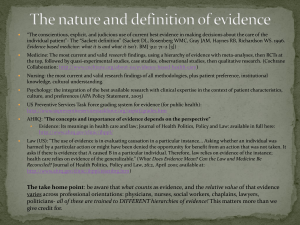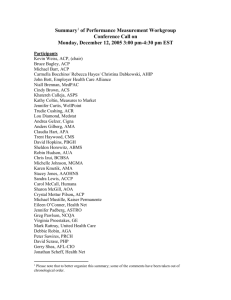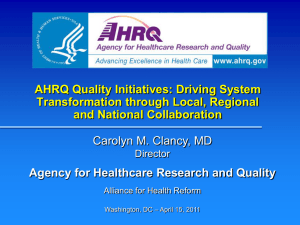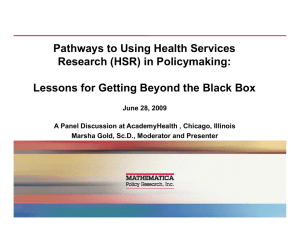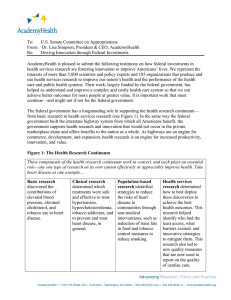6 om as a public service of the RAND Corporation.
advertisement
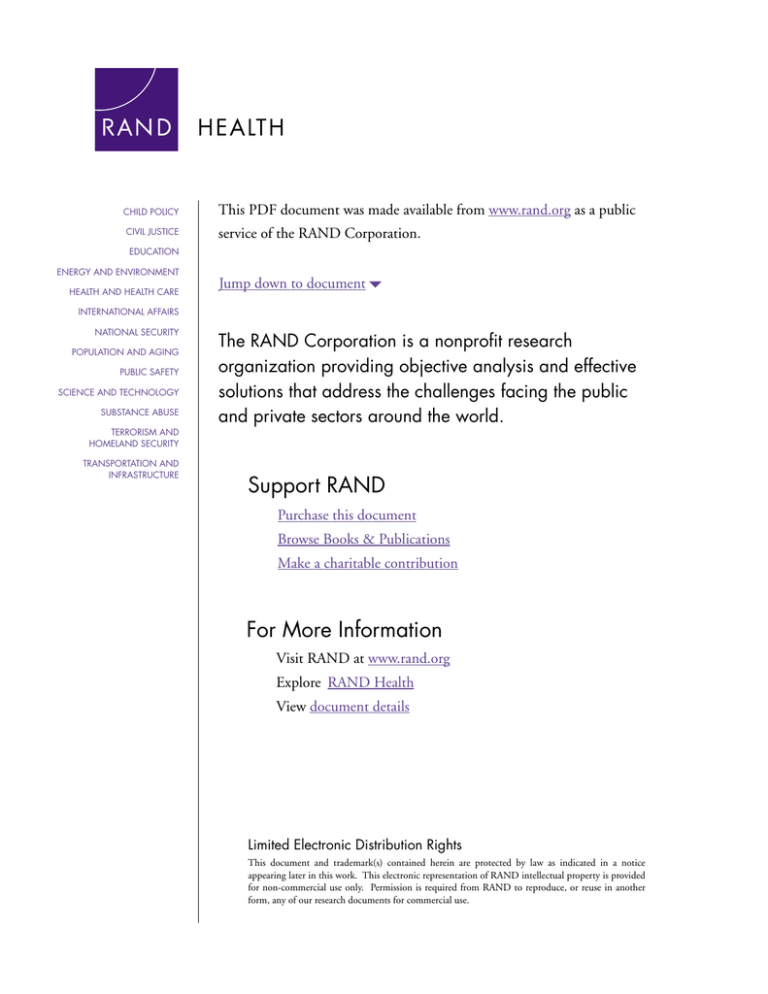
CHILD POLICY CIVIL JUSTICE This PDF document was made available from www.rand.org as a public service of the RAND Corporation. EDUCATION ENERGY AND ENVIRONMENT HEALTH AND HEALTH CARE Jump down to document6 INTERNATIONAL AFFAIRS NATIONAL SECURITY POPULATION AND AGING PUBLIC SAFETY SCIENCE AND TECHNOLOGY SUBSTANCE ABUSE TERRORISM AND HOMELAND SECURITY TRANSPORTATION AND INFRASTRUCTURE The RAND Corporation is a nonprofit research organization providing objective analysis and effective solutions that address the challenges facing the public and private sectors around the world. Support RAND Purchase this document Browse Books & Publications Make a charitable contribution For More Information Visit RAND at www.rand.org Explore RAND Health View document details Limited Electronic Distribution Rights This document and trademark(s) contained herein are protected by law as indicated in a notice appearing later in this work. This electronic representation of RAND intellectual property is provided for non-commercial use only. Permission is required from RAND to reproduce, or reuse in another form, any of our research documents for commercial use. This product is part of the RAND Corporation technical report series. Reports may include research findings on a specific topic that is limited in scope; present discussions of the methodology employed in research; provide literature reviews, survey instruments, modeling exercises, guidelines for practitioners and research professionals, and supporting documentation; or deliver preliminary findings. All RAND reports undergo rigorous peer review to ensure that they meet high standards for research quality and objectivity. Assessment of the National Patient Safety Initiative Context and Baseline Evaluation Report I Donna O. Farley, Sally C. Morton, Cheryl L. Damberg, Allen Fremont, Sandra H. Berry, Michael D. Greenberg, Melony Sorbero, Stephanie S. Teleki, Karen Ricci, Nancy Pollock Prepared for the Agency for Healthcare Research and Quality This work was sponsored by the Agency for Healthcare Research and Quality under contract No. 290-02-0010. The research was conducted in RAND Health, a division of the RAND Corporation. Library of Congress Cataloging-in-Publication Data Assessment of the national patient safety initiative : context and baseline evaluation report 1 / Donna O. Farley ... [et al.]. p. cm. “TR-203.” “Sponsored by the Agency for Healthcare Research and Quality under contract no. 290-02-0010”—Galley. Includes bibliographical references. ISBN 0-8330-3787-0 (pbk. : alk. paper) 1. Medical errors—Government policy—United States. 2. Iatrogenic diseases—Government policy—United States. 3. Patients—United States—Safety measures. [DNLM: 1. Medical Errors—prevention & control—United States. 2. Government Programs—United States. 3. Program Evaluation—United States. WB 100 A8388 2005] I. Farley, Donna. II. Rand Corporation. III. United States. Agency for Healthcare Research and Quality. R729.8.A875 2005 362.1—dc22 2005007121 The RAND Corporation is a nonprofit research organization providing objective analysis and effective solutions that address the challenges facing the public and private sectors around the world. RAND’s publications do not necessarily reflect the opinions of its research clients and sponsors. R® is a registered trademark. © Copyright 2005 RAND Corporation All rights reserved. No part of this book may be reproduced in any form by any electronic or mechanical means (including photocopying, recording, or information storage and retrieval) without permission in writing from RAND. Published 2005 by the RAND Corporation 1776 Main Street, P.O. Box 2138, Santa Monica, CA 90407-2138 1200 South Hayes Street, Arlington, VA 22202-5050 201 North Craig Street, Suite 202, Pittsburgh, PA 15213-1516 RAND URL: http://www.rand.org/ To order RAND documents or to obtain additional information, contact Distribution Services: Telephone: (310) 451-7002; Fax: (310) 451-6915; Email: order@rand.org EXECUTIVE SUMMARY Congress has placed a high priority on making a safer U.S. health care system. It has given a mandate to the Agency for Healthcare Research and Quality (AHRQ), an agency within the Department of Health and Human Services (DHHS), to establish a patient safety research and development initiative. This mandate holds AHRQ accountable for helping health care providers reduce medical errors and improve patient safety. AHRQ, in turn, is committed to improving patient safety in the U.S. health care system by ensuring that the extensive work supported by AHRQ and other organizations (1) addresses the many aspects of achieving safe health care practices; (2) identifies and fills gaps in knowledge on patient safety epidemiology and practices, and (3) is focused on effective identification and dissemination of successful patient safety practices. AHRQ contracted with RAND in September 2002 to serve as the evaluation center for the patient safety initiative. The evaluation center is responsible for performing a longitudinal evaluation of the full scope of AHRQ’s patient safety activities and providing regular feedback to support the continuing improvement of this initiative. The evaluation also is to assess overall initiative impacts, outcomes, and adoption diffusion using both qualitative and quantitative assessment approaches. This report is the first of what will be four annual reports prepared during the course of the longitudinal, formative evaluation, which are scheduled to be submitted to AHRQ in September of each year. This report presents findings on the history leading to the AHRQ patient safety initiative, the start-up of the initiative, and early activities through September 2003. By design, the initial evaluation focuses on assessing the context and goals that were the foundation for the patient safety initiative and developing baseline information for the process evaluation. The contents and format are designed to provide a stable conceptual framework for the longitudinal evaluation, within which results of each year’s assessment will be reported to develop a cumulative record of program evolution. In concurrent work, the evaluation continues to gather and assess information on the activities and evolution of the initiative, the results of which will be presented in subsequent annual reports. EVALUATION FRAMEWORK The Policy Context In early 2000, the Institute of Medicine (IOM) published the report entitled To Err is Human: Building a Safer Health System, which mobilized national efforts to improve the safety of the U.S. health care system (IOM, 2000). The IOM called for leadership from the DHHS in reducing medical errors, identifying AHRQ as the focal point for patient safety research and practice improvements. In response to the IOM report, the Quality Interagency Coordination Task Force (QuIC), a collaborative effort among federal agencies, 1 issued a report in February 2000 – Doing What Counts for Patient Safety, Federal Action to Reduce Medical Errors and Their Impact. This report laid out a strategy of more than 100 actions designed to create a 1 The QuIC is composed of members representing the Departments of Commerce, Defense, Health and Human Services, Labor, State, and Veterans Affairs; Federal Bureau of Prisons; Federal Trade Commission; National Highway Transportation and Safety Administration; Office of Management and Budget; Office of Personnel Management; and the U.S. Coast Guard. xi national focus on reducing errors, strengthen the patient safety knowledge base, ensure accountability for safe health care delivery, and implement patient safety practices. When the U.S. Congress established patient safety as a national priority and gave AHRQ the mandate to lead federal patient safety improvement activities, it provided AHRQ with funding to support related research and implementation activities. The AHRQ patient safety work is one of numerous and important patient safety initiatives being undertaken by a variety of organizations across the country. AHRQ’s leadership can provide motivation and guidance for the activities of others, and by integrating its work with that of other organizations in both public and private sectors, the agency can leverage finite resources and achieve synergy through collaboration. The CIPP Evaluation Model Through this longitudinal evaluation, which includes an annual reporting cycle, lessons from the current experiences of AHRQ and its funded projects can be used to strengthen subsequent program activities. As specified by AHRQ in the evaluation contract, the overall evaluation design is based on the CIPP evaluation model, which is a well-accepted strategy for improving systems that encompasses the full spectrum of factors involved in the operation of a program (Stufflebeam, et al., 1971; Stufflebeam, et al., 2000). The core model components are represented in the CIPP acronym: x Context evaluation assesses the circumstances stimulating the creation or operation of a program as a basis for defining goals and priorities and for judging the significance of outcomes. x Input evaluation examines alternatives for goals and approaches for either guiding choice of a strategy or assessing an existing strategy against the alternatives, including congressional priorities and mandates as well as agency goals and strategies. Stakeholders also are identified and their perspectives on the patient safety initiative are assessed. x Process evaluation assesses progress in implementation of plans relative to the stated goals for future activities and outcomes. Activities undertaken to implement the patient safety initiative are documented, including any changes made that might alter its effects, positively or negatively. Three questions are addressed in this evaluation phase: (1) is the initiative reaching the target population(s), (2) are delivery and support functions consistent with program design, and (3) are positive changes occurring as a result of these activities? x Product evaluation identifies consequences of the program for various stakeholders, intended or otherwise, to determine effectiveness and provide information for future program modifications. A Framework for the Process Evaluation To provide a cohesive framework for the process evaluation, we identified five system components that work together to bring about improved practices and a safer health care system for patients (see Figure 1.1). AHRQ is engaged in all of these system components, as are numerous other key organizations. The five system components are: (1) monitoring progress and maintaining vigilance; (2) knowledge of epidemiology of patient safety risks and hazards; (3) development of effective practices and tools; (4) building infrastructure for effective practices; and (5) broader adoption of effective practices. xii For this evaluation, we adopt a national perspective, with the goal of assessing the progress of the AHRQ initiative in helping to achieve a safer health care system. Accordingly, our examination recognizes AHRQ as one of the leaders in the large and growing field of patient safety improvement. The exploration of particular aspects of patient safety activities or new practices or information is conducted within the broader context of the health care system. Similarly, the assessment of the effects of AHRQ activities and those of other federal agencies includes consideration of their contributions to the larger patient safety system. FINDINGS FROM THE CONTEXT AND INPUT EVALUATIONS Context Evaluation The context evaluation documents the historical events that led to and framed the formation of the AHRQ patient safety initiative and identifies consequences for the AHRQ patient safety initiative. The following consequences were identified: x AHRQ leadership – a clear mandate by Congress for AHRQ to provide leadership in effecting change in patient safety practices x Balance research and implementation – the need for AHRQ to balance its traditional role of funding health services research with new activities to serve as a catalyst for bringing about changes that improve patient safety in the health care system. x Resource constraints –appropriation of funding that is small relative to the work to be done, including research to strengthen knowledge and actions to bring that knowledge to the health care community and increase adoption of safer practices. x Accountability for results – high expectations by Congress that AHRQ demonstrate progress in improving patient safety practice and reduction of harm to patients. x Coordination of multiple activities – a diversity of patient safety activities being undertaken by multiple public and private organizations, which requires a coordination role for AHRQ to achieve synergy among them and to encourage consistent standards of practice. Input Evaluation In this evaluation cycle, the input evaluation documents and assesses the start-up and initial operations of the AHRQ patient safety initiative. In general, both external leaders and the AHRQ staff believe the agency has done an impressive job in starting the patient safety initiative and has taken a productive approach for spending the $50 million on research to generate new knowledge. The initiative serves as a model for building multiyear budgets based on a trajectory of research and for explicitly linking investments in knowledge development in early years to translational and practice improvement activities in later years. Evaluation research also is an integral part of the initiative. In FY2000 and FY2001, AHRQ awarded patient safety grants for 81 research and demonstration projects, as well as other contracts and grants for other work for the patient safety initiative. A total of $160 million was obligated over the life of the multiyear projects. Of this total, $141.6 million was obligated for the 81 grants in seven project groups: Systems-Related Best Practices, Clinical Informatics, Centers of Excellence, Developmental Centers, Dissemination and Education, Reporting Demonstrations, and Working Conditions. The Systems-Related Best Practices grants were awarded in FY2000 before the first patient safety xiii appropriation was enacted. The remaining groups of grants were awarded in FY 2001 using the FY 2001 patient safety funding. (See Appendix A for summaries of the project groups.) In addition, AHRQ and the Health Resources and Services Administration (HRSA) have collaborated to enhance opportunities for exchange of information and synergy among the researchers for the AHRQ-funded grants and five HRSA-funded patient safety projects. The HRSA-funded grantees participated in patient safety conferences and other cross-grantee interactions. In the AHRQ reauthorization, Congress established an expanded role for AHRQ that encompasses not only its traditional role of supporting health care research but also the new role of stimulating changes in health care delivery practices. This new mandate has created ongoing tension between AHRQ’s research and implementation functions, within the constraints of a finite budget. AHRQ is a small agency, and although the patient safety budget is small relative to its mandate to achieve a safer health care system, it is large relative to AHRQ’s overall budget. Some concerns were raised in our stakeholder interviews that the patient safety initiative could crowd out the other programs for which AHRQ is responsible. ISSUES AND SUGGESTED AHRQ ACTIONS FROM THE PROCESS EVALUATION Monitoring Progress and Maintaining Vigilance The ability to measure patient safety events and monitor progress in practice improvements is the lynchpin to achieving safer health care in this country. It is essential to have an effective national patient safety data repository that can aggregate data from a diversity of participating organizations using consistent national standards to (1) provide the feedback and accountability to stimulate practice improvements by health care organizations, and (2) enable AHRQ to fulfill its accountability to Congress for achieving patient safety improvements. As a federal agency, AHRQ is in an excellent position to bring together the key stakeholders and facilitate decision making processes for establishing national data standards that would provide the foundation for a national data repository. Design and execution of such a national data resource is likely to be the most difficult challenge of the patient safety initiative, because it requires both technical expertise and successful collaboration across numerous levels and types of organizations. AHRQ’s strategy acknowledges the multiplicity of organizations and activities involved in patient safety measurement and reporting. It aims for collaboration in crafting a data system, using an incremental approach that leverages its initially funded projects into subsequent development of a national data capability. Ongoing work by AHRQ, the National Quality Forum (NQF), and others has yielded a growing number of patient safety measures. Substantial overlap in the measures developed by different organizations suggests there is convergence in thinking about the priority items. However, more work is needed to establish measures for services provided in a variety of settings, including ambulatory care, outpatient diagnostic and treatment services, long-term care, and home care. Suggestions for AHRQ Action x AHRQ should actively facilitate development work toward establishment of a national patient safety data repository, using a structured consensus process to select national xiv measures, develop the data standards and specifications, and delineate procedures for operation of the reporting network. x In identifying candidate measures, AHRQ should ensure that the most important safety aspects of the patient’s health care experience are identified and represented by the measures. x The process used by University of California at San Francisco (UCSF) and Stanford University to select the Healthcare Cost and Utilization Project (HCUP) patient safety indicators should be adapted by AHRQ for selection and definition of the broader set of national patient safety measures. x AHRQ should place a priority on the synthesis it plans to prepare of the knowledge, products, and newly tested reporting systems that will begin to emerge from the Reporting Demonstration projects during FY2004. x AHRQ should invite accreditation and credentialing organizations and insurers to be actively involved in the process for establishing national patient safety measures and designing a reporting network, with the goal of their adopting the measures as standards in their accreditation processes. Knowledge of Epidemiology of Patient Safety Risks and Hazards Our scan of the available data on the epidemiology of patient safety issues confirms that systematic or consistent estimates of the current incidence and severity of medical errors or adverse events do not yet exist. Numerous published papers report this information for specific issues, health care settings, and geographic locations, but the information has not been synthesized in a way that enables conclusions to be drawn about the country’s current patient safety status and the priority issues that merit attention. The projects in the patient safety portfolio are generating important new information on the epidemiology and causes of patient safety risks and hazards for a broad range of issues across a variety of patient care areas and settings. This new information has the potential to contribute substantially to the current state of knowledge of patient safety epidemiology. However, even when the epidemiological information generated from the patient safety projects is synthesized and interpreted, the synthesis is not expected to produce national-level estimates of the epidemiology of patient safety issues. The absence of standards for defining medical errors and adverse events, and for the measurement of these events, will preclude quantitative synthesis for many of the study results. The successful establishment of a national patient safety data repository would help provide such a capability. Suggestions for AHRQ Action x AHRQ should ensure that the results of epidemiological studies by the patient safety projects are summarized in usable forms for a variety of stakeholders and for future decisions on patient safety priorities. x Definitions and standards for measurement methods should be established by AHRQ as the basis for valid and consistent epidemiologic estimates for patient safety issues. xv x AHRQ should fund the development of a review report that summarizes the current state of knowledge on patient safety epidemiology and presents the best available estimates of the incidence and severity of errors and adverse events. x Future AHRQ funding for research on patient safety epidemiology should focus on topics that have been addressed least frequently thus far, placing a priority on areas that are high risk for patient harm. Development of Effective Practices and Tools Our review of the patient safety projects indicates that they are well positioned to expand the scientific evidence on the effectiveness of practices for improving patient safety, including issues of importance to vulnerable populations, specific practices that the patient safety evidence report identified as in need of further research, and substantial numbers of practices not rated by the evidence report. The preliminary information from our assessment is encouraging because it confirms that new ground is being covered, and it identifies several areas where further practice development and testing are needed. A full assessment of the contributions of the patient safety projects to the evidence base cannot be made until the projects publish their research results. AHRQ and other stakeholders should focus future research funding on the practices for which the need for more evidence is greatest. Suggestions for AHRQ Action x As the AHRQ-funded patient safety projects and other research generate new evidence on the effective practices, AHRQ should update the evidence report on patient safety to incorporate this evidence and should make the evidence information readily available to users through web-based and other communication media. x AHRQ should commit resources to define the standards of evidence that should apply for assessing the effectiveness of patient safety practices, and to determine methods for prioritizing which practices should be implemented. x Future AHRQ research funding should focus on testing patient safety practices that are promising, but for which evidence regarding their effects on safety outcomes is lacking or insufficient. x AHRQ should support work to document the costs, cost effectiveness, and return on investment of promising patient safety practices to make the business case for their adoption in the field. x To support health care organizations in adopting evidence-based patient safety practices, AHRQ should collaborate with users to establish implementation guides and tools with practical “how to” information that reduce barriers to implementation progress. Building Infrastructure for Effective Practices AHRQ has made tangible progress in developing infrastructure to support patient safety implementation activities. Virtually all of the groups of patient safety projects are addressing infrastructure issues, and two of the groups have infrastructure development as a primary goal. Two survey instruments will soon be ready for use by health care organizations to assess their patient safety culture and the extent to which hospitals are using adverse-event reporting xvi systems. Development of several components of a national data repository is underway in an incremental process, with more work planned in the near future. Strategic partnerships among AHRQ, researchers, federal and state agencies, private sector entities, and professional organizations will serve as the infrastructure for an initiative to support transformation of patient safety research findings into safer practice. However, as a federal agency, AHRQ is not in a position to “build” a patient safety infrastructure alone. A better metaphor might be that AHRQ is “seeding” patient safety infrastructures. AHRQ’s research network programs are impressive examples of “seeding” infrastructure by facilitating and funding creative partnerships among entities in the private sector that will ultimately become self-perpetuating. Suggestions for AHRQ Action x AHRQ should undertake a variety of partnerships with public and private sector organizations to explore creative ways for putting tested new patient safety products and knowledge into practice in the health care system. x AHRQ should pursue a focused strategy to integrate the patient perspective into activities to improve patient safety performance, including relevant research, consumer reporting on their experiences with care, and consumer involvement in activities by health care organizations. x AHRQ should explore mechanisms for establishing contingency financing of dissemination and implementation activities to provide flexibility to respond to needs or opportunities identified in the field. x Continued funding support should be provided for DCERPS and other projects that are beginning to build patient safety research infrastructure in order to enable them to become self-sustaining. x AHRQ should expand its efforts to take full advantage of its already established network infrastructures to serve as testing grounds for new patient safety interventions. Achieving Broader Adoption of Effective Practices The process of bringing new patient safety knowledge and products into widespread practice in the health care system requires both creativity and persistence. The primary players in adoption of improved patient safety practices are health care providers and other stakeholders with influence over them, including purchasers, insurers, accreditation and credentialing organizations, and consumers. By serving as a facilitator and technical resource for their activities, AHRQ has the opportunity to build synergy that will hasten the adoption of new practices for patient safety improvements. AHRQ will need to choose its initiatives strategically to leverage its limited resources for the greatest possible return on investment. The dissemination of findings and products from the patient safety projects represents an intersection of two challenges for AHRQ. The first is a structural challenge – the large number of projects that will be generating results, which the current system of health care publications does not have ready capacity to absorb. The second is a process challenge – the need for a creative and comprehensive dissemination strategy that will enable AHRQ and its grantees to effectively move the project output into the hands of a diverse mix of users and stakeholders. As AHRQ continues to develop and adjust its strategy, it can learn from its experience with the xvii dissemination process and draw upon the expertise and resources of public and private sector partners. Suggestions for AHRQ Action x AHRQ should design and carry out a cohesive strategy to disseminate the new knowledge and products of the patient safety projects to the broad spectrum of stakeholders that will put them into practice in the delivery of safer health care. x AHRQ should identify and test alternative strategies for AHRQ to serve as a catalyst that motivates and supports initiatives by health care organizations to implement new patient safety practices. x AHRQ should develop a monitoring process to measure the effects of individual implementation initiatives on patient safety practices and outcomes, as well as the cumulative effects of all the patient safety activities on key outcome measures. FUTURE DIRECTIONS AND PRIORITIES In the first year of the evaluation, we have observed, documented, and assessed the operations of the patient safety initiative, learning from participants and other stakeholders about the activities and interactions involved in the process. These individuals also have shared with us their concerns and ideas for future work. Drawing upon our assessments of the program context, inputs, and processes, we have identified four priorities that we believe in the aggregate will have the strongest positive impact on the future of the patient safety initiative. Accountability and Patient Safety Goals The high expectations initially set forth for achieving a 50 percent reduction in errors in five years have been replaced with recognition among participants and observers that the goal was both incorrect and unrealistic, especially given the relatively limited funding appropriated for the patient safety initiative. While setting a goal of low tolerance for errors and patient risk may be useful for establishing performance accountability, interim objectives must also be designed to pull the health care system toward that goal incrementally. In particular, there should be a realistic match between the objectives defined and the financial resources allocated for programming to achieve them. A National Patient Safety Data Repository The ability to measure patient safety issues and monitor progress in practice improvements nationally is one of the key components of a strategy for achieving safer health care in this country. An effective monitoring and measurement capability based on consistent national standards is essential to (1) provide the feedback and accountability to stimulate practice improvements by health care organizations and (2) enable AHRQ to fulfill its accountability to Congress for achieving patient safety improvements. We encourage AHRQ to continue to move actively on this aspect of the initiative, adjusting strategy as opportunities arise, and dedicating resources to the work. In particular, AHRQ can use its position as a federal agency to facilitate a consensus process with the goal of enhancing participation from multiple stakeholders across the country. xviii The Role of AHRQ in Making Practice Changes Happen As a federal agency, AHRQ operates in a unique external environment of legislative oversight and regulatory requirements. The conditions imposed by this environment create both advantages and constraints that influence AHRQ’s ability to stimulate and support improved patient safety practices in the nation’s health care system. While congressional requirements (e.g., procedural rules for funding projects, OMB approval requirements for survey data collection) provide important protections for the people of this country, they can also involve time-consuming procedures that slow down progress toward patient safety goals or discourage private sector participation. The aspect of the AHRQ patient safety initiative that may be most vulnerable to the federal bureaucracy is the translation of new knowledge into improvements in patient safety practices in the field. This mission involves AHRQ’s participation in active public-private partnerships, supporting health care organizations in their implementation activities. In this process, AHRQ and other participating organizations should make strategic use of the respective assets of the government and the private sector. Balancing Research and Adoption Activities During FY2004, the AHRQ patient safety initiative is entering a period of transition, as the existing projects conclude their research, the Patient Safety Improvement Corps (PSIC) enters the field, new Patient Safety Challenge Grants begin their work, and other activities move ahead to bring new knowledge and practices to end-users. During this process, AHRQ will be balancing internal staff activities and workload and deciding how best to use the new funding in the FY2004 budget. One could argue for applying more resources to implementation activities in order to achieve greater progress in the advancement of safer health care practices. However, AHRQ is unique as a funder of research, and reduction of AHRQ funding for priority research topics might well lead to some of them going unfunded. Relatively more of the resources of other federal or state agencies and the private sector might be used to undertake or support implementation initiatives, leveraging the funding available from AHRQ for this work. While there are no “correct” answers to this question, we encourage AHRQ to deliberate carefully to seek the optimal use of its finite resources, both human and financial. xix
